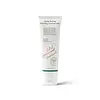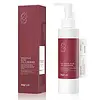What's inside
What's inside
 Key Ingredients
Key Ingredients

 Benefits
Benefits

 Concerns
Concerns

 Ingredients Side-by-side
Ingredients Side-by-side

Water
Skin ConditioningGlycerin
HumectantSodium Cocoyl Isethionate
CleansingSodium Methyl Cocoyl Taurate
CleansingPotassium Cocoyl Glycinate
Coco-Betaine
CleansingPotassium Cocoate
EmulsifyingPolyquaternium-67
Xylitylglucoside
HumectantCitric Acid
BufferingAnhydroxylitol
HumectantSodium Chloride
MaskingBetula Platyphylla Japonica Juice
Skin ConditioningXylitol
Humectant1,2-Hexanediol
Skin ConditioningGlucose
HumectantSodium Acetate
BufferingSodium Hyaluronate
HumectantButylene Glycol
HumectantTrehalose
HumectantAllantoin
Skin ConditioningChamomilla Recutita Flower Extract
MaskingGlycyrrhiza Glabra Root Extract
BleachingCamellia Sinensis Leaf Extract
AntimicrobialPerilla Frutescens Leaf Extract
MaskingOryza Sativa Bran Extract
Skin ConditioningHouttuynia Cordata Extract
Skin ConditioningCentella Asiatica Extract
CleansingCalendula Officinalis Flower Extract
MaskingDisodium EDTA
Potassium Benzoate
PreservativeWater, Glycerin, Sodium Cocoyl Isethionate, Sodium Methyl Cocoyl Taurate, Potassium Cocoyl Glycinate, Coco-Betaine, Potassium Cocoate, Polyquaternium-67, Xylitylglucoside, Citric Acid, Anhydroxylitol, Sodium Chloride, Betula Platyphylla Japonica Juice, Xylitol, 1,2-Hexanediol, Glucose, Sodium Acetate, Sodium Hyaluronate, Butylene Glycol, Trehalose, Allantoin, Chamomilla Recutita Flower Extract, Glycyrrhiza Glabra Root Extract, Camellia Sinensis Leaf Extract, Perilla Frutescens Leaf Extract, Oryza Sativa Bran Extract, Houttuynia Cordata Extract, Centella Asiatica Extract, Calendula Officinalis Flower Extract, Disodium EDTA, Potassium Benzoate
Water
Skin ConditioningGlycerin
HumectantCoco-Betaine
CleansingDipropylene Glycol
HumectantPotassium Cocoyl Glycinate
Acrylates Copolymer
Potassium Cocoate
EmulsifyingSalicylic Acid
MaskingCaprylyl Glycol
EmollientHydroxyacetophenone
AntioxidantPolyglyceryl-10 Myristate
Skin ConditioningEthylhexylglycerin
Skin ConditioningHibiscus Syriacus Flower Extract
AntioxidantDipotassium Glycyrrhizate
HumectantGlycolic Acid
BufferingXylitylglucoside
HumectantAnhydroxylitol
HumectantXylitol
HumectantGlucose
HumectantWater, Glycerin, Coco-Betaine, Dipropylene Glycol, Potassium Cocoyl Glycinate, Acrylates Copolymer, Potassium Cocoate, Salicylic Acid, Caprylyl Glycol, Hydroxyacetophenone, Polyglyceryl-10 Myristate, Ethylhexylglycerin, Hibiscus Syriacus Flower Extract, Dipotassium Glycyrrhizate, Glycolic Acid, Xylitylglucoside, Anhydroxylitol, Xylitol, Glucose
 Reviews
Reviews

Ingredients Explained
These ingredients are found in both products.
Ingredients higher up in an ingredient list are typically present in a larger amount.
This ingredient is created from dehydrating xylitol in acidic conditions. Xylitol is a famous sugar and humectant.
Much like its predecessor, anhydroxylitol is a humectant. Humectants attract and hold water to moisturize the skin.
This ingredient is most commonly found in a popular trio called Aquaxyl. Aquaxyl is made up of anhydroxylitol (24 - 34%), xylitylglucoside (35 - 50%), and xylitol (5 - 15%).
According to a manufacturer, Aquaxyl is known for a 3-D hydration concept and an anti-dehydration shield to reinforce the outer layer of skin.
This ingredient is often derived from plants such as wood and sugarcane.
Learn more about AnhydroxylitolCoco-Betaine is the natural version of Cocamidopropyl Betaine. It is often derived from coconuts.
Coco-Betaine is a surfactant, meaning it helps remove dirt and oil from the skin.
Glucose is a simple sugar and is the most important source of energy in all organisms.
In skincare, glucose is used to hydrate the skin. It also acts as a prebiotic for our natural biome.
Glucose is hydrating due to its humectant property. As a humectant, glucose draws moisture from the air and from deeper levels in the skin.
Our skin contains many sugars that act as prebiotics and help strengthen our natural microbiome. Having a healthy microbiome helps protect our skin from harmful bacteria and other contaminants.
Studies show glucose may help with fading discoloration and pigmentation. This is because our skin metabolizes glucose into lactic acid. Lactic acid is an AHA that helps exfoliate the top layer of skin.
Learn more about GlucoseGlycerin is already naturally found in your skin. It helps moisturize and protect your skin.
A study from 2016 found glycerin to be more effective as a humectant than AHAs and hyaluronic acid.
As a humectant, it helps the skin stay hydrated by pulling moisture to your skin. The low molecular weight of glycerin allows it to pull moisture into the deeper layers of your skin.
Hydrated skin improves your skin barrier; Your skin barrier helps protect against irritants and bacteria.
Glycerin has also been found to have antimicrobial and antiviral properties. Due to these properties, glycerin is often used in wound and burn treatments.
In cosmetics, glycerin is usually derived from plants such as soybean or palm. However, it can also be sourced from animals, such as tallow or animal fat.
This ingredient is organic, colorless, odorless, and non-toxic.
Glycerin is the name for this ingredient in American English. British English uses Glycerol/Glycerine.
Learn more about GlycerinThis ingredient is the potassium salt of coconut acid. Coconut acid is created by mixing fatty acids from coconut oil.
It is an emulsifier, surfactant, and cleanser. According to a manufacturer, it contains glycerin.
Potassium Cocoyl Glycinate is an amino acid-based surfactant and cleaning agent. This ingredient can be derived from animals or plants. It may also be synthetically created from fatty acids of the coconut and glycine.
Potassium Cocoyl Glycinate is a gentle surfactant. Surfactants help gather the dirt, oil, and other pollutants from your skin to be rinsed away. It is a mild cleanser and naturally produces foam.
Water. It's the most common cosmetic ingredient of all. You'll usually see it at the top of ingredient lists, meaning that it makes up the largest part of the product.
So why is it so popular? Water most often acts as a solvent - this means that it helps dissolve other ingredients into the formulation.
You'll also recognize water as that liquid we all need to stay alive. If you see this, drink a glass of water. Stay hydrated!
Learn more about WaterXylitol is a humectant and prebiotic. It can help with dry skin.
In studies, xylitol has been shown to improve dry skin. It decreased transepidermal water loss, or when water passes through the skin and evaporates. Xylitol also showed to help improve the biomechanical properties of the skin barrier.
The prebiotic property of xylitol may also help reinforce our skin's natural microbiome. Having a healthy microbiome prevents infection by bad bacteria and helps with hydration.
As a humectant, Xylitol helps draw moisture from both the air and from deeper skin layers. This helps keep skin hydrated.
Xylitol is a sugar alcohol and commonly used as a sugar substitute. It is naturally occurring in plants such as strawberries and pumpkin.
Learn more about XylitolXylitylglucoside is created from xylitol and glucose, two humectants.
Not surprisingly, this ingredient is also a humectant. It attracts and holds water in your skin, helping to maintain hydration.
This ingredient is most commonly found in a popular trio called Aquaxyl. Aquaxyl is made up of anhydroxylitol(24 - 34%), xylitylglucoside (35 - 50%), and xylitol (5 - 15%).
According to a manufacturer, Aquaxyl is known for a 3-D hydration concept and an anti-dehydration shield to reinforce the outer layer of skin.
Learn more about Xylitylglucoside